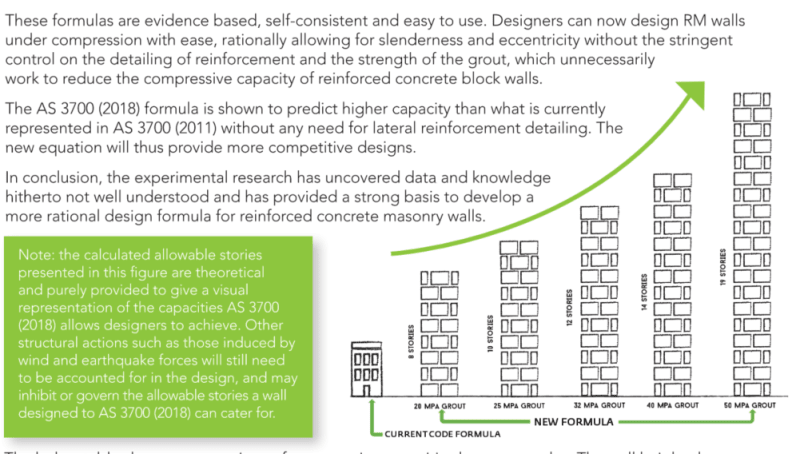Hi All,
Just curious as to what others are designing for in terms of a mu value for block buildings?
I had a certifier query a design for a building that was 5 levels but >15m and used block everywhere (including shear walls and cores). He said other engineers (in Brisbane) had told him that you cant use block for buildings greater than 15m. I don't think is right if you design for a mu=1.0 and the building lends itself to it i.e. regular/symmetrical floor plate with well distributed shear walls and no funky cantilevers or difficult transfers. If it remains elastic and you don't go down the mu=2.0 path then I don't think there is an issue.
Be keen to hear others thoughts as I believe there is a lot of confusion amongst engineers which also leads to confusion for our clients.
This is an extract of email reply keeping in mind audience was not structural, hope the engtips community agrees with my response to start educating other disciplines(?)
I believe there are numerous buildings above 15m still being designed in blockwork. Just because they are above 15m does not mean blockwork no longer becomes a viable material choice in my opinion.
The comments around this in the industry likely refer to designing earthquake loading on the building for a factor we call ‘mu’, specifically mu=2.0 and assuming the structure is designed incorporating limited ductile shear walls to resist the lateral loads acting on the structure. Adopting mu=2.0 means the building can ‘drift/sway/deflect’ and dissipate the EQ energy but needs to be detailed to achieve this without overloading vertical structural elements. The detailing requirements for achieving limited ductile shear walls make it difficult to achieve closed ligs (or ties) in a 190 blockwork wall to provide confinement to the vertical steel. This can make blockwork unviable for taller buildings due to constructability issues, not material choice.
There is research out via Tatheer @ QUT who suggests corefilled masonry blockwork walls can be considered as limited ductile walls and the confinement to the vertical steel is provided by an anulus of grout surrounding the bar. I personally have issues with this wrt to EQ as it is based on limited testing but the masonry association are fully on board with it and released the attached flyer. I think this only adds to the confusion within the industry around the latest AS3700 AND AS3600 codes when it comes to designing structures for EQ loading.
As an aside, the 15m is arbitrary and a line in the sand so to speak. A building 14m or 16m high will behave in a similar manner for instance.

Just curious as to what others are designing for in terms of a mu value for block buildings?
I had a certifier query a design for a building that was 5 levels but >15m and used block everywhere (including shear walls and cores). He said other engineers (in Brisbane) had told him that you cant use block for buildings greater than 15m. I don't think is right if you design for a mu=1.0 and the building lends itself to it i.e. regular/symmetrical floor plate with well distributed shear walls and no funky cantilevers or difficult transfers. If it remains elastic and you don't go down the mu=2.0 path then I don't think there is an issue.
Be keen to hear others thoughts as I believe there is a lot of confusion amongst engineers which also leads to confusion for our clients.
This is an extract of email reply keeping in mind audience was not structural, hope the engtips community agrees with my response to start educating other disciplines(?)
I believe there are numerous buildings above 15m still being designed in blockwork. Just because they are above 15m does not mean blockwork no longer becomes a viable material choice in my opinion.
The comments around this in the industry likely refer to designing earthquake loading on the building for a factor we call ‘mu’, specifically mu=2.0 and assuming the structure is designed incorporating limited ductile shear walls to resist the lateral loads acting on the structure. Adopting mu=2.0 means the building can ‘drift/sway/deflect’ and dissipate the EQ energy but needs to be detailed to achieve this without overloading vertical structural elements. The detailing requirements for achieving limited ductile shear walls make it difficult to achieve closed ligs (or ties) in a 190 blockwork wall to provide confinement to the vertical steel. This can make blockwork unviable for taller buildings due to constructability issues, not material choice.
There is research out via Tatheer @ QUT who suggests corefilled masonry blockwork walls can be considered as limited ductile walls and the confinement to the vertical steel is provided by an anulus of grout surrounding the bar. I personally have issues with this wrt to EQ as it is based on limited testing but the masonry association are fully on board with it and released the attached flyer. I think this only adds to the confusion within the industry around the latest AS3700 AND AS3600 codes when it comes to designing structures for EQ loading.
As an aside, the 15m is arbitrary and a line in the sand so to speak. A building 14m or 16m high will behave in a similar manner for instance.

